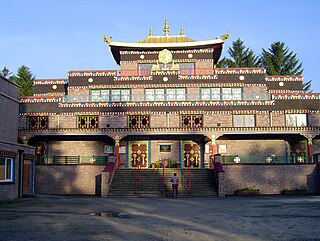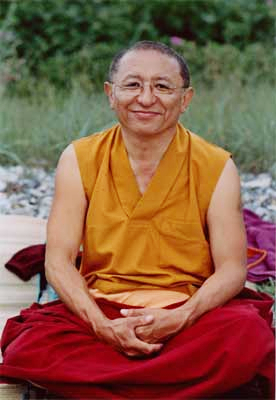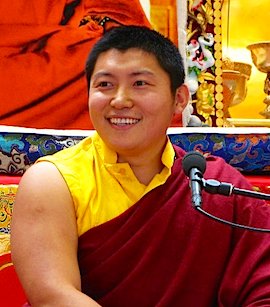Related Research Articles

Tibetan Buddhism is a form of Buddhism practiced in Tibet, Bhutan and Mongolia. It also has a sizable number of adherents in the areas surrounding the Himalayas, including the Indian regions of Ladakh, Sikkim, and Arunachal Pradesh, as well as in Nepal. Smaller groups of practitioners can be found in Central Asia, Xinjiang, Inner Mongolia, and some regions of Russia, such as Tuva, Buryatia, and Kalmykia.

Chögyam Trungpa was formally named the 11th Zurmang Trungpa, Chokyi Gyatso. A Tibetan Buddhist master and holder of both Kagyu and Nyingma lineages of Tibetan Buddhism, he was recognized by both Tibetan Buddhists and other spiritual practitioners and scholars as a preeminent teacher of Tibetan Buddhism. He was a major figure in the dissemination of Buddhism in the West, founding Vajradhatu and Naropa University and establishing the Shambhala Training method.
Buddhism in the West broadly encompasses the knowledge and practice of Buddhism outside of Asia in the Western world. Occasional intersections between Western civilization and the Buddhist world have been occurring for thousands of years. The first Westerners to become Buddhists were Greeks who settled in Bactria and India during the Hellenistic period. They became influential figures during the reigns of the Indo-Greek kings, whose patronage of Buddhism led to the emergence of Greco-Buddhism and Greco-Buddhist art. There was little contact between the Western and Buddhist cultures during most of the Middle Ages but the early modern rise of global trade and mercantilism, improved navigation technology and the European colonization of Asian Buddhist countries led to increased knowledge of Buddhism among Westerners. This increased contact led to various responses from Buddhists and Westerners throughout the modern era. These include religious proselytism, religious polemics and debates, Buddhist modernism, Western convert Buddhists and the rise of Buddhist studies in Western academia. During the 20th century, there was a growth in Western Buddhism due to various factors such as immigration, globalization, the decline of Christianity and increased interest among Westerners. The various schools of Buddhism are now established in all major Western countries making up a small minority in the United States, Europe, Australia and New Zealand.

Ole Nydahl, also known as Lama Ole, is a lama providing Mahamudra teachings in the Karma Kagyu school of Tibetan Buddhism. Since the early 1970s, Nydahl has toured the world giving lectures and meditation courses. With his wife, Hannah Nydahl (1946-2007), he founded Diamond Way Buddhism, a worldwide Karma Kagyu Buddhist organization with over 600 centers for lay practitioners.

Kagyu Samye Ling Monastery and Tibetan Centre is a Tibetan Buddhist complex associated with the Karma Kagyu school located at Eskdalemuir, Scotland.

Chöje Akong Tulku Rinpoche was a tulku in the Kagyu school of Tibetan Buddhism and co-founder of the Samye Ling Monastery in Scotland, Tara Rokpa Therapy & ROKPA International Charity.

Lama Yeshe Losal Rinpoche is a lama in the Kagyu school of Tibetan Buddhism and abbot of the Kagyu Samye Ling Monastery and Tibetan Centre, Scotland, the first and largest of its kind in the West.

Samye, full name Samye Mighur Lhundrub Tsula Khang and Shrine of Unchanging Spontaneous Presence, is the first Tibetan Buddhist and Nyingma monastery built in Tibet, during the reign of King Trisong Deutsen. Shantarakshita began construction around 763, and Tibetan Vajrayana founder Guru Padmasambhava tamed the local spirits for its completion in 779. The first Tibetan monks were ordained there. Samye was destroyed during the Cultural Revolution then rebuilt after 1988.

Diamond Way Buddhism is a lay organization within the Karma Kagyu school of Tibetan Buddhism. The first Diamond Way Buddhist center was founded in 1972 by Hannah Nydahl and Ole Nydahl in Copenhagen under the guidance of Rangjung Rigpe Dorje, 16th Karmapa. Today there are approximately 650 centers worldwide, directed by Ole Nydahl under the guidance of Trinley Thaye Dorje, one of two claimants to the title of the 17th Karmapa. Buddhist teachers such as Sherab Gyaltsen Rinpoche, Lama Jigme Rinpoche and Nedo Kuchung Rinpoche visit Diamond Way Buddhism centers and large meditation courses.

Although there was regular contact between practising Buddhists and Europeans in antiquity the former had little direct impact. In the latter half of the 19th century, Buddhism came to the attention of Western intellectuals and during the course of the following century the number of adherents has grown. There are now between 1 and 4 million Buddhists in Europe, the majority in Italy, Germany, Hungary, France and the United Kingdom.

Buddhist traditions are represented in South Africa in many forms. Although the inherently introspective nature of Buddhism does not encourage census, adherents to these traditions are usually outspoken and supported by perhaps an even greater, though hidden number of sympathisers. Temples, centres and groups are common in the metropolitan areas and the country is thought to comprise the largest Buddhist community in Africa.
Namgyal Rinpoche, Karma Tenzin Dorje (1931–2003), born Leslie George Dawson in Toronto, Canada, was a Tibetan Buddhist lama in the Karma Kagyu tradition.

Buddhism in the United Kingdom is the fifth-largest religious group in the United Kingdom. The 2021 United Kingdom census recorded just under 290,000 Buddhists, or about 0.4% of the total population, with the largest number of Buddhists residing in Greater London and South East England. According to a Buddhist organisation, the growth of Buddhism in the United Kingdom is mainly a result of conversions.

Karma Thinley Rinpocheཀརྨ་འཕྲིན་ལས་རིན་པོ་ཆེ་, is an important master of the Kagyu Mahamudra, Sakya Lamdré and Chod traditions of Tibetan Buddhism active in the west and Nepal. He is also well regarded by Tibetans as a scholar, poet and artist.

Buddhism in Scotland is a relatively recent phenomenon. In Scotland, Buddhists represented about 0.3% of the population (15,501) in the 2022 census.

Chökyi Nyima Rinpoche is a Tibetan Buddhist teacher and meditation master. He is the abbot of Ka-Nying Shedrub Ling Monastery in Kathmandu, Nepal. He is the author of several books, founder of meditation centers around the world, and an international teacher.
Lama Chime Tulku Rinpoche is a Tibetan Buddhist, Tulku and Dharma teacher. Chime Rinpoche was born in 1941 in Kham, Tibet. In 1959, due to the annexation of Tibet, he was forced to flee to India via Bhutan into exile. Gaining British citizenship in 1965, he taught extensively throughout Europe and established Marpa House, the first Tibetan Buddhist Centre in England. His students include American author and Buddhist nun Pema Chödrön and musicians Mary Hopkin, David Bowie and Tony Visconti.

Kagyu Samye Dzong London Tibetan Buddhist Centre for World Peace and Health is the London branch of Kagyu Samye Ling Monastery in Scotland. Kagyu Samye Dzong London is under the direct guidance of Chöje Akong Tulku Rinpoche and Venerable Lama Yeshe Losal Rinpoche, the co-founder and Abbot of Samye Ling respectively.

Phakchok Rinpoche is a teacher of the Nyingma lineage and chief lineage holder of the Taklung Kagyu lineage of Tibetan Buddhism. He is Vajra Master of Ka-Nying Shedrup Ling monastery, abbot of several monasteries in Nepal, and assists monasteries and practice centers in Tibet. In addition, he serves as Director of the Chokgyur Lingpa Foundation, a nonprofit organization engaged in a wide range of humanitarian projects.

The mind teachings of Tibet are a body of sacredly held instructions on the nature of mind and the practice of meditation on, or in accordance with, that nature. Although maintained and cultivated, to various degrees, within each of the major Tibetan Buddhist traditions, they are primarily associated with the mahamudra traditions of the Kagyu and the dzogchen traditions of the Nyingma.
References
- ↑ "Facebook". www.facebook.com. Retrieved 30 September 2023.
- 1 2 3 4 "Rob Nairn, profile on Samye Ling web site" . Retrieved 7 August 2008.
- ↑ Nairn RG, To Read or Not to Read, Aspects of Prisoners' Rights, South African Journal of Criminal Law and Criminology, 3, 57-60, 1979
- ↑ "Holistic shop Interview with Rob Nairn". Archived from the original on 18 April 2009. Retrieved 7 August 2008.
- ↑ "Home". mindfulnessassociation.org.
- ↑ "Rob's Home in Africa | Rob Nairn". Archived from the original on 14 September 2011. Retrieved 21 January 2012.
- ↑ "Rob Nairn's 2007-2008 programme on the Meditation Centre for World Peace (Reykjavík, Iceland) website". Archived from the original on 13 August 2016. Retrieved 16 April 2008.